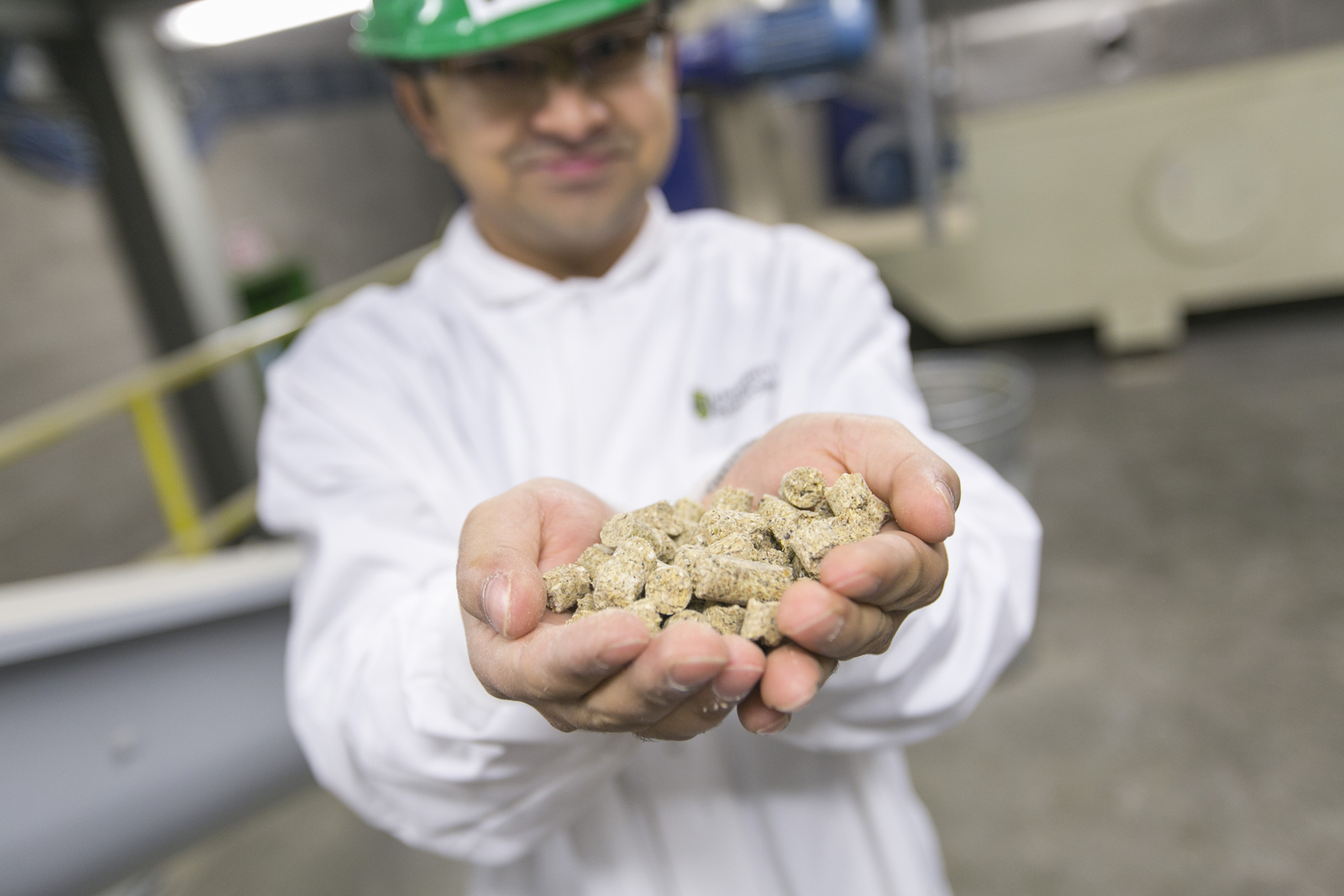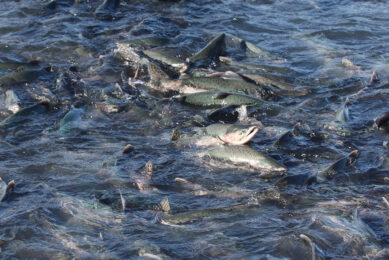Effect of vacuum coating on broiler feed

With higher utilisation of high protein and low energy ?co-products (e.g. canola meal or DDGS) in broiler diets, higher levels of fat inclusion are required. But how do you ensure that high levels of fat don’t create problems during feed pelleting? Canadian researchers looked into the effects of vacuum coating.
By Santosh Lamichhane (MSc Student) and Tom Scott (Research Chair in Feed Processing Technology), Canadian Feed Research Centre, University of Saskatchewan, Canada
Vacuum coating is a simple physical process, in which air inside the pellet pores is pumped out to create a near vacuum, then pellets are mixed with liquid (fats, bioactives, nutraceuticals) and pressure then released which “pulls” the coated liquid deep into the pellet pores (Figure 1). Vacuum coating is used primarily for aqua and pet feeds; which are extruded not pelleted. Lower density (e.g. higher porosity) in extruded feed allows incorporation of higher amounts of liquid by vacuum coating. For example, with vacuum coating it is possible to include up to 40% fats in extruded fish feeds. The high density of pellets possess challenges for use of vacuum coating. However, it is felt that an increased understanding of diet formulations and pelleting processes would supply opportunities to improve porosity without reducing pellet durability (PDI). This will improve the use of vacuum coating for higher inclusion of fats and heat sensitive bioactives in broiler pellets.
Vacuum coating of broiler pellets
Regarding the addition of fats, it has been well established that there are limitations to pre-pellet fat inclusion. Inclusion of high (>5%) fat in the mixer compromises pellet durability. However, with higher utilisation of high protein and low energy co-products (e.g. canola meal or DDGS) in broiler diets, higher levels of fat inclusion are required. In this scenario, high level of fats can be incorporated in pellets post-pelleting with the use of vacuum coating and minimising fines in the feed.

Vacuum coater (500 kg batch) at Canadian Feed Research Centre, University of Saskatchewan.
Protection of bioactives
There is increasing use of high pellet conditioning temperature (80 to 900 C) to improve pellet quality, inactivate anti-nutritional factors and pathogens, and improve digestibility of the ingredients and performance. However, this can destroy heat sensitive feed bioactives (i.e. enzymes, probiotics etc.) when added before pelleting. Post-pellet spray applications will alleviate this, but it is more difficult to get consistent application and there is potential for the applied bioactive to be lost as fines (e.g. that are recirculated and destroyed during re-conditioning). However, with vacuum coating, the bioactives are drawn into the pellet pores improving homogeneity as well as reducing loss with fines. This could reduce the levels of bioactives required and possibly improve retention of their activity during storage or digestion. Similarly, vacuum coating can also mask offensive odour of ingredients (e.g. organic acids, essential oils, etc.) and improve working conditions and feed intake. With increasing restriction of AGPs, higher use of vaccines are required to keep flocks healthy and improve food safety. The use of vacuum coating may facilitate easier delivery of intact vaccines via the feed; as the gut is considered a major site of immunological response.
Challenges
The most significant challenge for vacuum coating pelleted feed is the capacity to increase porosity (pore size and/or number) to achieve higher uptake of liquids without losses in pellet durability. The following is a short description of the first research conducted at the University of Saskatchewan’s new Canadian Feed Research Centre and a part of Santosh Lamichhane’s MSc programme. Other work is planned to determine how the use of vacuum coating influences the economics and interest of the market place.

The Canadian Feed Research Centre, University of Saskatchewan, which was officially opened in October 2014.
Effect of particle size tested
At the Canadian Feed Research Centre (University of Saskatchewan), an experiment was conducted to evaluate the effect of particle size on porosity and post-pellet liquid absorption with and without vacuum application. Three grains; wheat, barley and corn either ground or unground were used to produce 3 particle sizes (whole, 3.2 and 6.4 mm) in pellets (4.7 mm). Following pelleting, porosity (using a porosimeter to measure % air space in pellets), bulk density and PDI were measured before coating with 15% canola oil without (VC-) and with (VC+; 0.3 bar) vacuum coating. With coarse and fine grinding, barley had the highest particle size followed by wheat and corn (Table 1). The porosity of whole grain pellets were lower than the coarse or fine grind pellets for all the grains. Similarly, for wheat and corn, porosity of coarsely ground grain pellets were higher than for finely ground grain pellets. However, for barley, the porosity of coarse and fine was different. Oil absorption was highest when fine grind barley pellets were vacuum coated. In case of corn, like wheat, coarse particle pellets had more oil absorption than the fine or whole pellets. Vacuum coating improved oil absorption of all pellets (Figure 2).
Protection of xylanase
Another experiment was conducted to evaluate the use of vacuum coating for protection of xylanase and effect on broiler performance when fed wheat-rye-based diet. The study showed no effect of vacuum coating of enzyme on broiler performance (body weight, feed efficiency and feed intake). However, post-pellet vacuum coating of xylanase had higher (7%) retention of enzyme activity in comparison to post pellet spraying without vacuum (VC-; Figure 3). There is very little information on the use of vacuum coating as a means of preserving heat sensitive feed additives. Despite the lack of any effect on the performance of broilers, some promising results have been found. Vacuum coating protected heat sensitive additives and prevents losses from high conditioning temperature or loss with fines.
Conclusion
Vacuum coating protected enzyme activity but the effect on broiler performance was not observed. However, this may indicate that with vacuum coating lower levels of enzyme may be applied with no loss in production. We also must better understand the interactions between ingredients, grinding and pelleting to optimise porosity and PDI. Furthermore, this needs to be integrated with all the variables associated with vacuum coating. Lastly, initial evaluations indicate that NIR (near infrared reflectance) can easily predict fat absorption and this can be a suitable means to measure pellet porosity. AAF
The authors acknowledge the funding support of the Canadian Poultry Research Council (CPRC) and the National Science and Engineering Council (NSERC). References are available on request.
Join 26,000+ subscribers
Subscribe to our newsletter to stay updated about all the need-to-know content in the feed sector, three times a week. Beheer
Beheer









 WP Admin
WP Admin  Bewerk bericht
Bewerk bericht